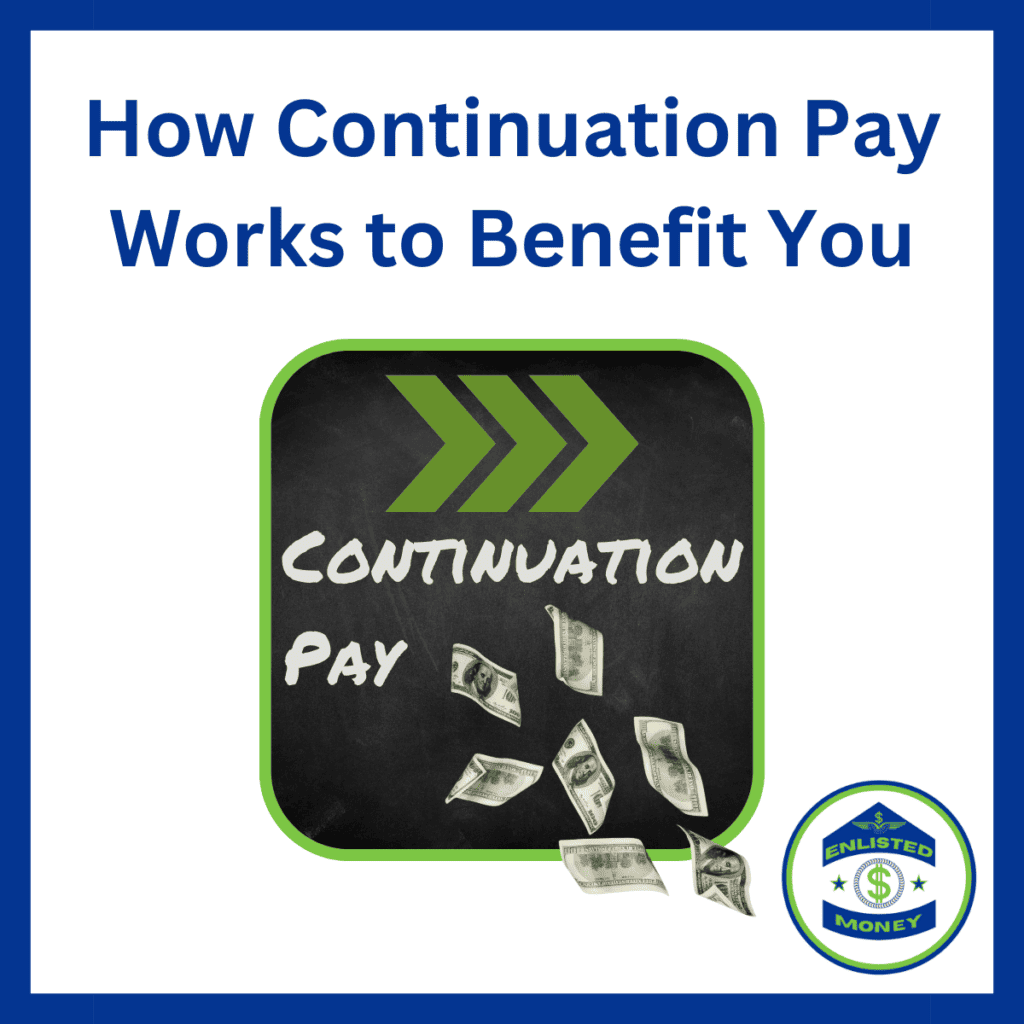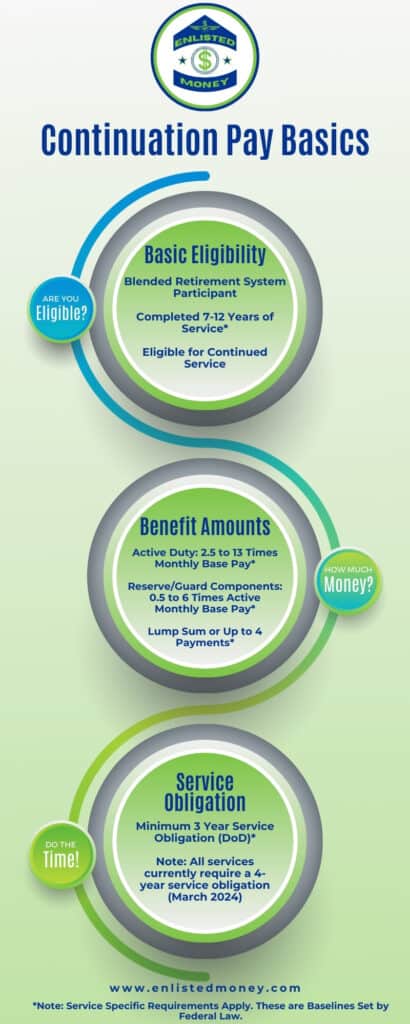
Continuation Pay is probably the least understood benefit within the Blended Retirement System (BRS). Many service members don’t know what Continuation Pay is, miss the cutoff to request the bonus, or are downright confused about how Continuation Pay works. It’s not surprising because it’s really difficult to find any single place to understand the program and there are all kinds of guesses and rumors out there.
I hope to help alleviate some confusion, debunk some myths, and give you a great baseline understanding of what Continuation Pay is, how it works, and how to create a strategy to take full advantage of this program. This is a lengthy article, but I promise it’ll be worth your time to read it.
This is the first of two articles I’m planning to write on Continuation Pay. I’ll cover service-specific guidance and share some stories of service members who’ve requested and received their Continuation Pay. Follow me on Instagram and/or sign up for the Enlisted Money newsletter to be notified when that drops.
- Background on Continuation Pay
- Debunking Some Continuation Pay Myths
- How Continuation Pay Works
- How to Maximize Your Continuation Pay Benefits
- How Continuation Pay is Calculated
- Do You Have to Pay Continuation Pay Back if You Don’t Stay?
- Is Continuation Pay Worth It?
- Start Early, Create More Options
- Connect with the Enlisted Money Community
Background on Continuation Pay
Continuation Pay was part of the initial roll-out of the BRS. It has evolved a bit over the years and the individual branches of services have all made their own policies. These changes have all occurred through the passing of the National Defense Authorization Act (NDAA) starting with NDAA 2016. I’ll briefly walk through these changes.
NDAA 2016 – The Birth of the Blended Retirement System and Continuation Pay
The National Defense Authorization Act for Fiscal Year 2016 created the Blended Retirement System (BRS) and with it, Continuation Pay (CP). The original program was much more limited to receiving Continuation Pay at 12 years of service for a 4-year service obligation.
There’s still some literature floating around on Reddit and elsewhere with this original information. In some cases, this may still be true because each branch of service has a range of options to implement Continuation Pay as they see fit. For instance, the Marines still follow closely with the original program guidelines.
NDAA 2017 – Expansion to Range of Years of Service Served
The largest modification to Continuation Pay was done with NDAA 2017, which stated: ‘‘(d) TIMING OF PAYMENT. —The Secretary concerned shall pay Continuation Pay under subsection (a) to a full TSP member when the member has completed not less than 8 and not more than 12 years of service in a uniformed service.”
In other words, it was no longer limited to the 12-year mark only – the services had options. This NDAA also changed the minimum service obligation to 3 years of service. However, all services currently still require 4 years of service (as of March 2024).
NDAA 2018 – Coast Guard Gets Continuation Pay Funding
There was one paragraph in NDAA 2018 to authorize Coast Guard Continuation Pay funding. Gotta take care of them too!
NDAA 2024 – Change to Years of Service Requirements
There was another change to the years of service requirements in NDAA 2024. Now Continuation Pay is allowed as early as 7 and up to 12 years of service. However, this is an expansion of the allowance for individual services – not a requirement. No services currently offer Continuation Pay at 7 years of service as of this writing (March 2024).
Debunking Some Continuation Pay Myths
I feel it’s important to help debunk some Continuation Pay myths. I hear all kinds of things and honestly, even people who should know the answers are having a hard time deciphering between fact and fiction. Here are the most common myths I’ve encountered.
Myth: Continuation Pay Will Reduce My Pension – False
Nope! Continuation Pay will NOT reduce your pension at 20 years (and beyond) of service. I believe this myth came from people incorrectly equating any mid-career bonus to the old (and horrible) REDUX Career Status Bonus. Please forget that REDUX ever existed! This was a terrible program for most service members who took it and was discontinued at the same time BRS was implemented.
Continuation Pay DOES NOT reduce your pension and you aren’t even required to stay until retirement if you take CP. You only have to serve the additional service obligation.
Myth: Continuation Pay is a Reenlistment Bonus – False
Although Continuation Pay is related to retention, it’s separate from any other bonuses and pay. I know this is a bit confusing because you’ll need to prove you’re able to reenlist to request Continuation Pay. And, you may have to re-up to meet service obligations.
However, this isn’t an actual reenlistment bonus, and you would request reenlistments and extensions separately from Continuation Pay. You should consider Continuation Pay as a separate entitlement/bonus from reenlistment bonuses or other bonus and incentive programs. You may want to space these two out (more on that later).
Think of CP as a close cousin of re-up bonuses – not a twin. It’s not a choice between the two. Continuation Pay doesn’t affect your eligibility for other bonuses or incentives or the other way around.
Myth: The DoD Allows for [Specific Item], So My Service Must Offer It – False
The law sets the left and right limits of Continuation Pay. However, the individual services set their policies within those parameters. Also, each service publishes annual guidance, so things can change between when you and a battle buddy may have requested Continuation Pay.
How Continuation Pay Works
Now that we’ve talked about what Continuation Pay is not, let’s discuss what it actually is and if you’re eligible. First off, you must be in the Blended Retirement System to be eligible. You can request Continuation Pay for continuing to serve in the military. However, you don’t have to request it if you don’t want CP and you’re not automatically given Continuation Pay either. If you miss the time-frame to request it, there’s no going back.
Basic Eligibility
Here are your basic eligibility requirements:
- Be a BRS Participant
- Have completed 7 up to 12 Years of Service
- Note: All services currently offer Continuation Pay starting at 8 years of service or later.
- Be Eligible for Continued Service
The baseline benefits you’ll receive are:
- Bonus Equal to a Minimum of:
- Active Duty: 2.5 Times Monthly Base Pay Up to 13 Times Monthly Base Pay
- Reserve/Guard Components: 0.5 Times Active Monthly Base Pay Up to 6 Times Active Monthly Base Pay
- Can Be in a Lump Sum or Up to 4 Annual Payments (on the anniversary of original payment)
You’ll incur a service obligation:
- Minimum 3 Year Service Obligation (DoD)
- Note: All services currently require a 4-year service obligation (March 2024)
Keep in mind that these are all baseline allowances set by law and the Department of Defense. Each branch of the military can set its policy within these parameters.

How to Maximize Your Continuation Pay Benefits
The next logical question is how to maximize your Continuation Pay. The first step to maximizing Continuation Pay is to plan ahead so you’re not deciding at the last minute. You’ll also want to give yourself plenty of time to process your request.
Lump Sum vs Multiple Payments
As mentioned before, you can elect to take Continuation Pay via lump sum or up to 4 equal payments. Check with your service to see what they allow. There are a few things to consider here like taxes, other bonuses in the same year, adding Continuation Pay into your TSP, etc.
How is Continuation Pay Taxed?
Continuation Pay is taxable. This could potentially push your income into a higher tax bracket. Several factors affect your tax rate such as filing status (married vs single) and other income to consider.
You’ll see some tax withheld from your Continuation Pay (22% withholding just like a reenlistment bonus). The actual pay you’ll get is going to be less than the face value amount.
However, just because you have 22% withheld doesn’t mean that’s the amount of tax you’ll actually pay. Depending on your income, there’s a good chance you’ll get a lot of that back when you file your taxes.
Seek out a free MilTax advisor or check out the Military Tax Experts Alliance (MTEA) for paid options.
Combat Zone Tax Exemptions
If you happen to be in a combat zone when you’re receiving Continuation Pay, this could mean you’d get your Continuation Pay tax-free. This might prove exceedingly difficult to pull off though. I just want you to be aware of this because it could be a big benefit to you.
How Do Taxes Affect My Decision
Assuming you’re not deployed, spreading your Continuation Pay across several years would help limit your taxable income from having a big spike in a single year. The idea would be to keep all your pay within the lowest tax brackets.
This can be even more important if you’re dual military or have other taxable income. Once again, your personal situation will dictate what to do here.
Receiving Other Bonuses
If you’re reenlisting around the same time and lucky enough to get a bonus, you might not want to take the lump sum CP option. Once again, this depends, but you don’t want to pay extra taxes unless you have to. If at all possible, I’d think about reenlisting in the year before your eligibility for Continuation Pay. This way you’re not going to get both of these bonuses at the same time.
However, waiting to take Continuation Pay or reenlist could prove risky. I’d tell you to consider “striking while the iron is hot” because timing bonuses can be hard to do. If the current bonus goes away, you might miss out completely. I’ve consistently missed all the biggest bonuses for my MOS (no fault of my own). Also, the services can change continuation pay eligibility requirements whenever they want.
As an example, the Army currently offers CP for 8 to 12 years of service for Calendar Year 2024. In 2025, they’ve released a plan to change the years of service. I’ve tried to keep up with the Army’s CP changes in my other article here. However, that’s been pretty difficult because the Army didn’t follow the plan they put out (go figure) and doesn’t publish everything immediately to the public either.
Thrift Savings Plan Contributions and Your Match
Another thing to consider is putting some or all of your Continuation Pay into your Thrift Savings Plan. You should think about putting Continuation Pay into your TSP. You have to make this election in MyPay where you set your TSP contributions.
Once you reach the annual contribution limit ($23,500 for 2025), you can’t contribute to your TSP and, therefore, will not get your matching contributions for the rest of the year. However, if you spread this out over four years, you could calculate your contributions to factor in your Continuation Pay and potentially max your contributions and get all your matching contributions too.
Regardless, you should still get the 1% agency match as long as you haven’t exceeded the total annual contribution limit ($70,000 for 2025).
You’ll also need to consider whether to put it into your traditional or Roth TSP account. This is specific to your financial situation, but there are lots of benefits to Roth. You can update the options for what pay gets routed into your TSP and whether it’s going into the Roth or Traditional using MyPay.
How Continuation Pay is Calculated
The basic calculation for Continuation Pay is your monthly active base pay (one, single month of base pay) multiplied by the service component’s Continuation Pay multiplier. So, if your monthly active duty base pay is $4,500 and your service multiplier is the minimum of 2.5, your Continuation Pay would be $11,250. Not bad! However, technically, this could be even more depending on your rank and time in service.
Taking Advantage of Longevity, Promotion, and Cost-of-Living Increases for Continuation Pay
For some services, you can request Continuation Pay as early as eight years of service. The advantage is you’ll start your additional service obligation period sooner. However, you’ll miss out on getting a larger bonus amount from your years of service increases, potential for getting promoted, and annual pay increases.
As an example, if you requested Continuation Pay in year 9, but you received a promotion in year 10, another TIS pay increase, and a cost-of-living increase, your Continuation Pay would be significantly higher if you had waited. However, like I mentioned earlier, services can change this at any time.
If you know you want to stay for 20 years, then waiting to request until your 11th year of service, to receive Continuation Pay at your 12-year mark may be the best. In some services like the Marine Corps, this is your only option. The answer I received as to why the Marine Corps wanted to ensure a “full and fair” computation of Continuation Pay for Marines. This method ensures they receive the maximum amount of Continuation Pay at 12 years of service instead of the 10 years of service pay rate.
Note: Marines still must request CP before their 12-year mark, but they will get paid at the 12-year TIS rate. This is always subject to change.
Change in Status Considerations
If you know you’ll have a change in status like becoming an Officer, Warrant Officer, switching to a different component, changing MOS, etc. you may want to consider those factors as well.
Also, if you were on the fence about making a change, you might want to take CP into consideration.
Do You Have to Pay Continuation Pay Back if You Don’t Stay?
In short, yes, at least partially. If you elect to receive Continuation Pay and do not serve the required service obligation, you will have to pay back a prorated portion of Continuation Pay. So, if your Continuation Pay was $10,000 for 4 years and you only served an additional 3 years, you’d owe $2,500. If you take continuation pay, you need to plan to serve the whole service obligation.
Don’t try to “game the system” for a short-term need with the intention of leaving service before your obligation was served. Waiting to take the bonus until you’re in an “indefinite” or “career status” contract may be the best option. This is a serious decision with financial consequences. Regardless, you incur a service obligation, so your service isn’t just going to let you walk away.
There are some exceptions to recoupment, but plan to serve the time if you take the pay.
Is Continuation Pay Worth It?
Let’s talk about the hard part – should you stay in service to get this bonus? I can’t speak for all the branches, but my experience in the Army is that nobody will take care of you and your family as well as you do.
If you’ve been saving for retirement your whole career, you probably don’t have to stay for the pension alone. That’s a good thing for you, not so much for your service. This bonus is timed to get you “over the hump” and create enough inertia (sunk-cost fallacy) to get you to stay for 20 years or more.
The DoD knows that once you get to 16 years of service, you are highly unlikely to leave service.
You’re Never Truly Stuck – If You’ve Been Saving
I’ll tell you this, if you’ve been saving for retirement, you have all the cards in your hand. Trust me, the military probably needs you more than you need the military at this point. If you’ve been investing in yourself, you’ll be very marketable.
The status quo is to try to convince you that once you’re over 10-12 years in service you “might as well” stay to 20. Nothing has created more stress in my life than this sunk-cost fallacy mentality. In fairness, I’ll benefit greatly from my eventual pension (I’m so close!), but if I could go back in time, I would have invested sooner and given myself more confidence to leave.
Only you can decide whether to stay or not. I would personally think about what’s best for you and your family first, then worry about taking Continuation Pay or reenlisting. I’ve seen lots of families (including mine) struggle because they prioritized the promise of a pension over their family. It does you absolutely no good to get a pension at 20 years if it costs you a relationship with a spouse or child.
Start Early, Create More Options
If you’re reading this early in your military career, I BEG YOU to start saving and investing for your future now. You want to be able to solve the money problems first so you can make decisions based on what’s best for you and your family – not just because you “need” the money.
Big Thanks to Dan Huffman!
I really appreciate Dan Huffman, owner of Cornerstone Financial Planning, for taking the time to review the article and give me feedback. He’s been a huge support to me in the last year. Thanks!
Connect with the Enlisted Money Community
I hope this was helpful to you. If you have any questions, please comment below, or shoot me an email at hello@enlistedmoney.com. I’d love to hear your stories on Continuation Pay! Also, please consider signing up for the Envestor Community newsletter to stay up to date on new content, changes, and tips to help you on your financial journey.
